Hyde Park Corner, a large traffic roundabout situated at one of the city’s busiest junctions southeast of Hyde Park, includes a large concentration of monuments and memorials.
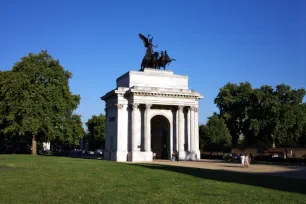
The streets that converge here include Park Lane, Grosvenor Place, Piccadilly, Knightsbridge and Constitution Hill. Thankfully, a number of pedestrian tunnels allow visitors to safely cross the high-trafficked roads that surround the roundabout.
Wellington Memorials
There is an abundance of monuments on Hyde Park Corner. Two of these were built in honor of Arthur Wellesley, the first Duke of Wellington, who lived here, in Apsley House.
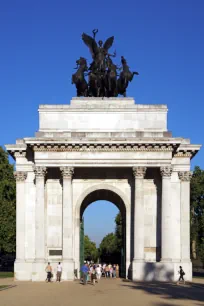
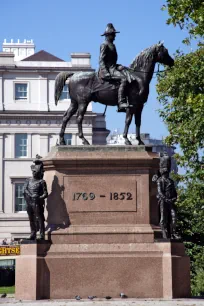
Wellington Arch
The centerpiece of Hyde Park Corner is the Wellington Arch, also known as Constitution Arch. The triumphal arch was commissioned in the 1820s to celebrate the victory of the Duke of Wellington over Napoleon at Waterloo.
This grand monument was designed by Decimus Burton and was to serve as a triumphal gateway to London and as a northern gate to the grounds of Buckingham Palace. Atop the arch sits a monumental sculpture group by Adrian Jones, which was installed in 1912 and is known as “The Angel of Peace Descending on the Quadriga of Victory”.
Wellington Statue
Originally, a giant equestrian statue of the Duke of Wellington stood atop Wellington Arch. The enormous, forty-ton-weighing statue was placed there in 1846, but it was soon considered too large and out of proportion to the arch, so it was removed in 1883, shortly after the duke’s death.
Instead, a new statue of the duke was commissioned in 1884 which was cast from cannons that had been captured from the French. When it was completed in 1888 the statue was not placed on the top of the arch, but on a pedestal. The equestrian statue shows the duke facing his former home, Apsley House. He is mounted on his favorite war horse, Copenhagen, which he rode for more than sixteen hours during the Battle of Waterloo. When the horse died in 1836 it was buried with military honors.
The statue, created by Joseph Boehm, rests on a granite pedestal. At the corners are four statues of soldiers that represent regiments that were led in battle by Wellington.
More Memorials
There are also several World War I and II memorials on Hyde Park Corner, all of a very different design.
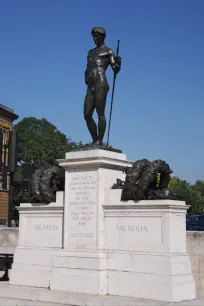

Machine Gun Corps Memorial
One such memorial is the Machine Gun Corps Memorial, designed by Francis Derwent Wood and erected in 1925 to honor those members of the corps who died during World War I. It’s sometimes called the “Boy David” monument because atop it sits a statue of the young David leaning on the sword of Goliath. Four wreaths wrapped around machine guns and helmets rest on the pedestal.
Royal Artillery Memorial
In complete contrast to the allegorical Machine Gun Corps Memorial is the massive Royal Artillery Memorial, dedicated to Royal Artillery members who died in the Great War. It was unveiled in the same year, 1925, on the west side of Hyde Park Corner. The memorial was designed by the sculptor Charles Sergeant Jagger, who himself had fought in the war.
The monument is defined by the stone reproduction of a howitzer that Jagger integrated in the design, which at the time was the cause of much controversy. Around the howitzer are large bronze figures of artillerymen. Remarkably, one of them is dead, his body covered with a coat and helmet. In 1949 the memorial was also dedicated in honor of the artillerymen who fell in the Second World War.
Australian War Memorial and New Zealand War Memorial
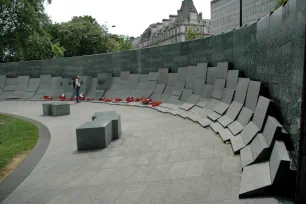
There are two more recent memorials on Hyde Park Corner that commemorate the bonds between Great Britain and two of its former territories. In the south-west corner is the Australian War Memorial, designed by Tonkin Zulaikha Greer Architects and Janet Laurence.
Inaugurated in 2003, the monument pays homage to the Australians who died in the two World Wars. It consists of a curving wall inscribed with the names of hundreds of Australian towns and, in much larger letters, the names of the places where the soldiers fought. Water flows continually over the wall’s inscriptions.
On the other side of Hyde Park Corner are the sixteen bronze beams of the New Zealand War Memorial, which was dedicated in 2006. The memorial commemorates the bond between New Zealand and the United Kingdom in the two World Wars and honors the New Zealand soldiers who perished during the wars. The memorial was designed by John Hardwick-Smith and Paul Dibble. Inscribed on the beams are symbols that are representative of New Zealand culture.
Hyde Park Corner Screen


The Hyde Park Corner Screen sits on a separate traffic island, between Piccadilly Arcade and Hyde Park. It is a thirty-three meter (107ft) wide gate with three arches connected by an Ionic colonnade. The gate was designed in 1825 by Decimus Burton as an entrance to Hyde Park.
Apsley House
The eighteenth-century Apsley House, which sits next to the Hyde Park Screen, was once the residence of Arthur Wellesley, the first Duke of Wellington. Today, the building houses a museum dedicated to the duke, who is best known as the leader of the British forces who defeated Napoleon at Waterloo with the help of Prussian forces.
The museum houses a collection of paintings from masters such as Velázquez, Goya, van Dyck, Teniers and the American painter John Singleton Copley. Some of the furniture and objects that once belonged to the Duke of Wellington are also on display, most notably a three meter-tall nude statue of Napoleon.

